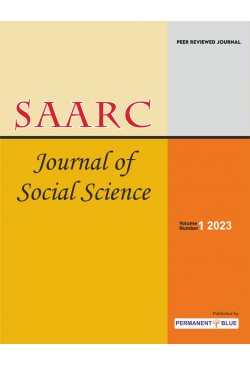MARK YOUR PRESENCE IN THE ACADEMIC WORLD. JOIN PERMANENT BLUE TO FULFIL YOUR INTELLECTUAL PURSUIT.
Table of Content :-SAARC Journal of Social Science, Vol:1, Issue:2, Year:2023
The Buddhist Revival and Social Change in Contemporary Sri Lanka
By :-Mahesh Premarathna
SAARC Journal of Social Science, Year:2023, Vol.1 (2), PP.93-113
Received:30 June 2023 | Revised:23 July 2023 | Accepted :03 August 2023 | Publication:10 December 2023
Mahesh Premarathna (2023). The Buddhist Revival and Social Change in Contemporary Sri Lanka. SAARC Journal of Social Science, 1: 2, pp. 93-113.
Poverty Reduction and Pro-poorness Growth in Bihar and Jharkhand: A Comparative Analysis
By :-Jitendra Kumar Sinha
SAARC Journal of Social Science, Year:2023, Vol.1 (2), PP.115-131
Received:09 June 2023 | Revised:11 August 2023 | Accepted :19 August 2023 | Publication:10 December 2023
Jitendra Kumar Sinha (2023). Poverty Reduction and Pro-poorness Growth in Bihar and Jharkhand: A Comparative Analysis. SAARC Journal of Social Science, 1: 2, pp. 115-131.
Narrative Technique and the Craft of Creative Writing: Fundamental Concepts, Aspects and Dimensions
By :-Yash Deep Singh
SAARC Journal of Social Science, Year:2023, Vol.1 (2), PP.133-145
Received:09 July 2023 | Revised:11 August 2023 | Accepted :19 August 2023 | Publication:10 December 2023
Yash Deep Singh (2023). Narrative Technique and the Craft of Creative Writing: Fundamental Concepts, Aspects and Dimensions. SAARC Journal of Social Science, 1: 2, pp. 133-145.
Chronic Unemployment in South Africa: Whose Role is it to Create Jobs in a Developmental State?
By :-Mawere J., Matoane J. and amp; Mukonza R.M.
SAARC Journal of Social Science, Year:2023, Vol.1 (2), PP.147-160
Received:19 July 2023 | Revised:05 September 2023 | Accepted :19 September 2023 | Publication:10 December 2023
Mawere J., Matoane J. & amp; Mukonza R.M. (2023). Chronic Unemployment in South Africa: Whose Role is it to Creat Jobs in a Developmental State?. SAARC Journal of Social Science, 1: 2, pp. 147-160.
Ecological Alienation of West Bengal’s Buxa Hill Residents in Alipurduar Area: An Assessment of the Environmental Development Process
By :-Bappi Singha
SAARC Journal of Social Science, Year:2023, Vol.1 (2), PP.161-172
Received:10 September 2023 | Revised:10 October 2023 | Accepted :22 October 2023 | Publication:10 December 2023
Bappi Singha (2023). Ecological Alienation of West Bengal’s Buxa Hill Residents in Alipurduar Area: An Assessment of the Environmental Development Process. SAARC Journal of Social Science, 1: 2, pp. 161-172.
New Education Policy 2020: Its Prospects of Internationalization
By :-Surjya Narayan Tripathy
SAARC Journal of Social Science, Year:2023, Vol.1 (2), PP.173-193
Received:14 November 2023 | Revised:28 November 2023 | Accepted :01 December 2023 | Publication:10 December 2023
Surjya Narayan Tripathy (2023). New Education Policy 2020: Its Prospects of Internationalization. SAARC Journal of Social Science, 1: 2, pp. 173-193.
